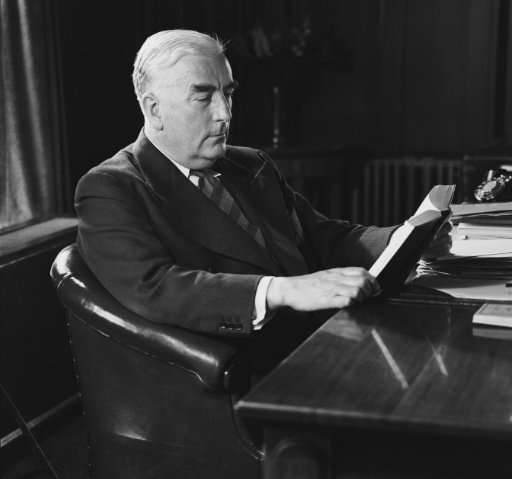On this day, 20 December 1894, Robert Gordon Menzies is born in the small Victorian township of Jeparit, out the back of the general store which his parents James and Kate ran. He is named after his paternal grandfather, who had been born in Scotland before emigrating to Australia, and the imperialist war hero General Charles George Gordon, killed in the siege of Khartoum in 1885.
Menzies’s father James had been a coach-painter in Ballarat before moving to Jeparit on the invitation of Kate’s brother Sydney Sampson, who ran the local newspaper and who would later enter Federal Parliament as a Protectionist and an Anti-Socialist. Both parents were involved in the multi-faceted work of the general store, with Kate serving behind the counter and engaging in millinery and drapery, while James managed the groceries, boot and saddlery section, and worked at servicing machinery for customers.
The experience of the small business taught Robert to value hard work, self-discipline and thrift, values that were reinforced by the family’s pervasive Protestantism. Though a Presbyterian by conviction, the tininess of the town led to James serving as a Methodist lay-preacher, a role in which he became known for his emotive speaking. This raw emotion and James’s strict Calvinism carried over into his strictness and stern physical discipline with his children, though James also had an artistic streak and the negative effects of his outbursts were somewhat softened by Kate’s less conditional affection.
Robert was the fourth of five children, however the last came more than a decade later in 1905, so he was effectively the youngest for much of his upbringing. His elder brother Frank was given the middle name ‘Gladstone’, indicative of the classical liberal politics which the family supported. Robert was closest to his sister Belle, who was the nearest to him in age, and who therefore shared in many of his childhood escapades. In an era before electricity had reached the town, the children had to make their own fun, swimming in the nearby Lake Hindmarsh and being entertained by the native fauna that were abundant around the area. On one occasion the children got caught feeding the animals of a visiting circus, a misdemeanour for which the boys were severely beaten, while Belle’s punishment was ‘hearing what happened to your brothers’.
Jeparit had around just 200 citizens by the turn of the century, and in 1894 that number may well have been under 100. It had been founded in the 1880s to service wheat growers hoping to utilise the water of Lake Hindmarsh, though even with this reservoir the residents would frequently be plagued by drought. The general store was naturally the centre of such a small world, particularly as James was known to give his struggling customers extensive credit. James consequently established himself as a community leader, serving as a member of Dimboola Shire Council and president of the Jeparit Branch of the Australian Natives’ Association, then later, once he had moved to Melbourne, representing the broader district in the Victorian State Parliament.
Politics ran in Robert’s blood on both sides, for his maternal grandfather John Sampson had been a dedicated unionist, a founder of the Miners’ Association, and a strike leader – an interesting contrast with the anti-socialism of his son Sydney. When young Robert was sent to school in Ballarat, living with his paternal grandmother Elizabeth, he would often visit John with whom he would read the Worker newspaper and debate the merits of its left-leaning articles.
For her part, Elizabeth imbued a remarkable work ethic and devotion to reading, despite the fact that the only books she owned were the Bible, the famous puritan allegory The Pilgrim’s Progress, and a collection of myths and poetry known as The Ingoldsby Legends. This dedication would see Robert top the Victorian schools’ scholarship examination. These scholarships, 40 in total, were then the only way in which poor students in the State could hope to attend the equivalent of high school. It was through this path that Menzies attended first Grenville College and then, once his parents relocated to Melbourne, the far more prestigious Wesley College.
Initially Menzies struggled at Wesley, but by his third year he won one of 25 State-wide ‘exhibition’ scholarships for the University of Melbourne, the last steppingstone in a remarkable rise from a relatively poor boy on the fringes of Victorian civilisation, to a self-confident young man studying at the premier learning academy in what was then still functioning as the Federal Capital. In 1966 the citizens of Jeparit would pay tribute to this elevation by erecting a spire topped with a Scotch thistle (Menzies having recently been knighted in the order of the thistle), dedicating the monument to Sir Robert with a plaque reading:
‘This spire has been erected by the people of Jeparit and district, to honour Sir Robert Menzies. The spire symbolises the rise to world recognition of a boy who was born in Jeparit and who rose by his own efforts to become Australia’s Prime Minister and a statesman recognised and honoured throughout the world.’
Further Reading:
Troy Bramston, Robert Menzies: The Art of Politics (Scribe, 2019).
A.W. Martin, Robert Menzies, A Life: Volume 1 1894-1943 (Melbourne University Press, 1993).
Sign up to our newsletter
Sign up for our monthly newsletter to hear the latest news and receive information about upcoming events.


